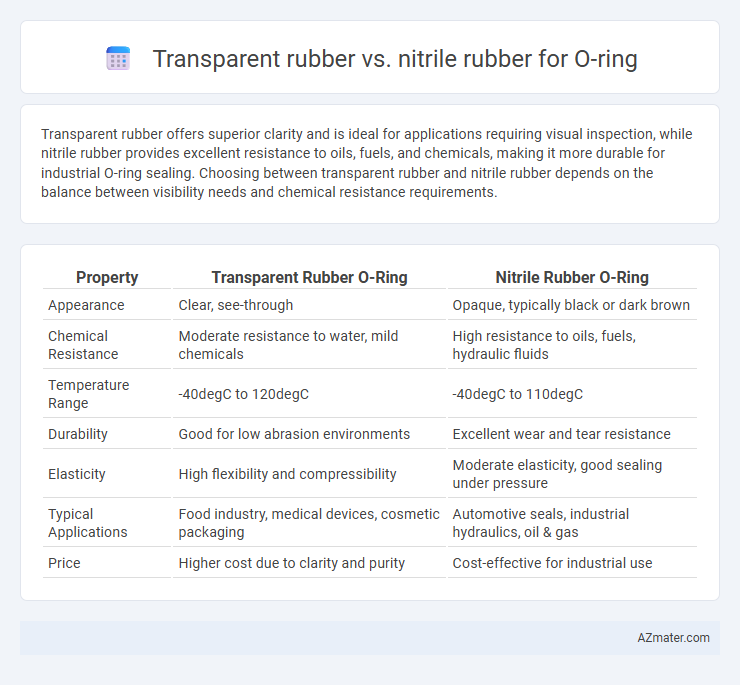Transparent rubber offers superior clarity and is ideal for applications requiring visual inspection, while nitrile rubber provides excellent resistance to oils, fuels, and chemicals, making it more durable for industrial O-ring sealing. Choosing between transparent rubber and nitrile rubber depends on the balance between visibility needs and chemical resistance requirements.
Table of Comparison
| Property | Transparent Rubber O-Ring | Nitrile Rubber O-Ring |
|---|---|---|
| Appearance | Clear, see-through | Opaque, typically black or dark brown |
| Chemical Resistance | Moderate resistance to water, mild chemicals | High resistance to oils, fuels, hydraulic fluids |
| Temperature Range | -40degC to 120degC | -40degC to 110degC |
| Durability | Good for low abrasion environments | Excellent wear and tear resistance |
| Elasticity | High flexibility and compressibility | Moderate elasticity, good sealing under pressure |
| Typical Applications | Food industry, medical devices, cosmetic packaging | Automotive seals, industrial hydraulics, oil & gas |
| Price | Higher cost due to clarity and purity | Cost-effective for industrial use |
Overview of O-Ring Materials
Transparent rubber O-rings offer excellent visibility and aesthetic appeal, making them ideal for applications requiring visual inspection and light exposure resistance. Nitrile rubber O-rings provide superior chemical resistance, particularly to oils, fuels, and greases, ensuring durability in industrial and automotive environments. Selection between these materials depends on the need for transparency versus chemical resilience and temperature stability.
What is Transparent Rubber?
Transparent rubber is a clear, flexible elastomer used for applications requiring visibility and aesthetic appeal, often made from silicone or polyurethane materials. It offers excellent resistance to UV light, ozone, and weathering, making it ideal for seals and O-rings in environments where clarity and durability are essential. Unlike nitrile rubber, which is opaque and excels in oil and fuel resistance, transparent rubber is chosen for its transparency and moderate chemical resistance in non-extreme conditions.
What is Nitrile Rubber?
Nitrile rubber, also known as Buna-N, is a synthetic elastomer widely used for O-rings due to its excellent resistance to oils, fuels, and chemicals, making it ideal for automotive and industrial applications. It offers superior durability and temperature resistance compared to transparent rubber, which is more limited in chemical compatibility and mechanical strength. Nitrile rubber's strong sealing performance and cost-effectiveness make it the preferred choice for demanding environments where leak prevention and material resilience are critical.
Key Material Properties Comparison
Transparent rubber offers excellent visual inspection capabilities and superior flexibility, making it ideal for applications requiring clarity and elasticity. Nitrile rubber provides exceptional chemical resistance, especially against oils, fuels, and solvents, along with high tensile strength and durability in harsh environments. Both materials vary significantly in temperature tolerance and abrasion resistance, with nitrile rubber generally outperforming transparent rubber in extreme industrial conditions.
Chemical Resistance: Transparent vs Nitrile Rubber
Nitrile rubber offers superior chemical resistance compared to transparent rubber, excelling in resistance to oils, fuels, and various hydrocarbons, making it ideal for industrial and automotive O-ring applications. Transparent rubber generally exhibits lower chemical resistance, particularly to oils and solvents, limiting its use to less aggressive environments where visibility and aesthetic clarity are prioritized. O-ring selection should consider chemical exposure to ensure optimal durability and sealing performance.
Temperature Performance Differences
Transparent rubber O-rings typically offer moderate temperature resistance, performing well within the range of -30degC to 70degC, making them suitable for general-purpose applications. Nitrile rubber O-rings excel in temperature performance, withstanding temperatures from -40degC to 120degC, which enables their use in more demanding environments involving heat and oil exposure. The superior thermal stability and resistance of nitrile rubber make it a preferred choice for applications requiring extended durability under fluctuating or elevated temperatures.
Mechanical Strength and Flexibility
Transparent rubber O-rings typically exhibit lower mechanical strength compared to nitrile rubber, making them less suitable for high-pressure or heavy-duty applications. Nitrile rubber offers superior tensile strength and excellent resistance to abrasion, enhancing durability and performance under mechanical stress. Flexibility in transparent rubber allows for better visual inspection and application in low-stress environments, whereas nitrile rubber maintains optimal flexibility across a wider temperature range without compromising its structural integrity.
Applications: Where Each Material Excels
Transparent rubber O-rings excel in applications requiring visual inspection and light transmission, such as medical devices, food processing equipment, and consumer electronics, where clarity and aesthetic appeal are crucial. Nitrile rubber O-rings outperform in automotive fuel systems, hydraulic machinery, and oil-resistant seals due to their exceptional resistance to petroleum-based oils, fuels, and chemicals under high-pressure conditions. Each material's unique chemical compatibility and mechanical properties dictate its optimal use, with transparent rubber favored for clarity and nitrile rubber for durability in harsh, oil-exposed environments.
Cost Considerations and Availability
Transparent rubber O-rings typically incur higher costs due to the specialized materials and manufacturing processes required to achieve clarity, which can limit their availability compared to nitrile rubber O-rings. Nitrile rubber O-rings offer a cost-effective solution with widespread availability, making them a preferred choice for many standard sealing applications. The durability and chemical resistance of nitrile combined with its lower price and extensive market presence ensure consistent supply and reduced procurement expenses.
Choosing the Right O-Ring Material for Your Needs
Transparent rubber O-rings offer excellent visibility and flexibility, making them ideal for applications requiring visual inspection and moderate chemical resistance. Nitrile rubber O-rings provide superior oil and fuel resistance along with high tensile strength, suitable for automotive and industrial sealing in harsh environments. Choosing the right O-ring material depends on factors such as chemical exposure, temperature range, and mechanical stress to ensure optimal performance and durability.

Infographic: Transparent rubber vs Nitrile rubber for O-ring
 azmater.com
azmater.com